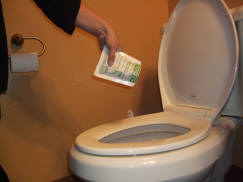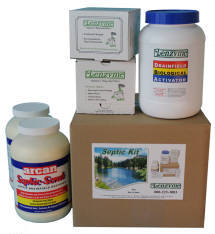



Bio - Products, Packaging & Marketing Experts

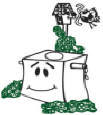

Understanding the Microbial Balance of a Drainfield
It is the method to distribute the water from the septic tank to the ground to be absorbed. It must accept water almost every day and dispose of it in order to repeat the process the next day. This soil absorption system is a very complex biological and chemical ecosystem. It is susceptible to upsets and can deteriorate over time. Keeping the right biological balance in the septic drainfield is very important to its health.
All Rights Reserved - Lenzyme - 2010 - 2020
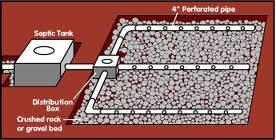
Understanding how a septic system functions will help you make better decisions on how to care for your system. A traditional anaerobic septic system has a soil absorption area (drainfield) which consists of an area of ground tested for percolation rate, soil type, and other drainage characteristics. These tests will show the location to be suitable for the absorption of a fixed quantity of water per day. Oxygen in the soil is not tested, but may be the most important component of a soil absorption area. Oxygen is also the least understood aspect of a properly operating drainfield. Each component of the drainfield plays a role in a functioning soil absorption area. Proper preparation of the soil, the components which distribute the water, proper depth, and ground cover each play a significant part.
Proper sizing of the septic tank to allow for retention time, baffles, and an outlet filter are also important. In addition, pumping the septic tank on a regular schedule of at least every three years is critical. Cleaning the septic tank filter regularly and maintaining the biological activity in your septic tank can help ensure that the septic system continues to function and absorb water in an environmentally acceptable manner. The soil absorption area is the most expensive component of the septic system.
A traditional septic drainfield has two types of bacteria present, aerobic (uses oxygen) and anaerobic (doesn’t use oxygen). In this system, when water containing nutrients flows into the soil absorption area, a biologically active film develops. This slime layer (commonly called the “biofilm or bio-mat”) is composed of bacteria and their waste products. This slime is actually a chemical compound secreted by the bacteria to anchor themselves to the bottom and sidewalls of the drainage piping, the aggregate in the absorption bed, the soil interface, and to each other to prevent being washed away by the water flow through the septic system. The bacteria serve a vital purpose in a septic system by absorbing the organic waste, removing pathogens, and breaking it down into soluble byproducts. Without these beneficial bacteria, the septic system would not work. If your septic system is not working properly it has a very high potential of polluting the groundwater and possibly your own drinking water.
The buildup of this black slime is the number one reason of a slow draining system. The more the buildup, the slower the water transferring through it. If left unchecked it will build up to a point where the drainfield will not accept any more wastewater and the soil absorption area will fail. Causing major problems for the system owner such as messy and smelly backups. At the point of failure the system will need to be cleaned to reduce the biofilm or worse yet be replaced at substantial cost to the septic system owner.

This film grows by adding aerobic bacteria to the outside of the film and the inside of the film has anaerobic bacteria. The water coming from the septic tank has already been depleted of oxygen and is thus an anaerobic environment. It is oxygen from the soil that allows the activity of the aerobic bacteria. This aerobic activity is important to the digestion of waste from the septic tank. Aerobic bacteria digest waste faster and more efficiently than anaerobic bacteria. Recent evidence has shown that the biofilm is composed of both aerobic and anaerobic bacteria. As the biofilm thickens, which results from use of the system, the anaerobic bacteria can grow underneath the aerobic bacteria. This protects them from oxygen, which would kill them off.
These anaerobic bacteria use the sulfur from the waste as their source of energy. The byproducts of these bacteria include a form of sulfur called sulfides. One of the characteristics of sulfides is the “rotten egg smell” which we associate with septic or sewer systems. Sulfides also have a characteristic in which they react with metals, mostly iron in soil and water, to a form a black, very insoluble, and very sticky material which is very detrimental to the environment and health of the septic system. In the presence of oxygen, these sulfides slowly react with oxygen to form soluble sulfates which wash down into the soil. Therefore, a properly functioning drainfield will have a balance of both aerobic and anaerobic conditions present. If oxygen is depleted in the drainfield the anaerobic bacteria take over and build a strong hold. This creates a situation in the drainfield where a black slime will grow. This black material is mainly iron sulfide.
The removal of available oxygen is the main reason that this occurs. If the waste coming from the septic tank has a high biological oxygen demand, then the oxygen from the soil may not be enough to supply both the aerobic bacteria and the removal of sulfides. This causes the sulfides to build-up with the result being increased anaerobic bacteria activity and more sulfides are then produced. This thickening of this biological film slows the transfer of water and digestion of waste from the septic tank. The system becomes more anaerobic with the build up of more sulfides. These sulfides build up on the bio-mat and at the interface where the drainfield media and the soil meet. This slows the transfer of water into the ground. The characteristics of the soil and plant coverage over a drainfield and depth of the laterals can also affect the amount of oxygen which can penetrate the soil. Many septic owners have more septic tank problems after heavy rain because the total amount of water in the absorption area is flooding the soil pores and reducing the amount of oxygen available to the drainfield.
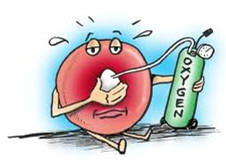
Why does the rate of water absorption change with use? What may cause the long term water absorption rate to be less than the initial percolation test rate and then continue to decrease over time? The answers to these questions lie in the characteristics of the soil, the oxygen requirements of the waste from the septic tank, and the amount of water added to the system. If you notice the soil above your septic system is constantly moist, there is a problem. The long term acceptance rate of the soil was tested by a percolation test before the system was installed. But we all know wet soil does not absorb water as fast as new soil or soil that has been dry for a period of time. The wet soil above your system is probably due to more anaerobic biological activity within the bio-mat and the resulting insoluble slime and clogging by-products. At this point your system is out of balance. There is a thicker layer of anaerobic bacteria than aerobic bacteria.
Since this activity can slow the absorption of water, this is one reason why a drainfield should be larger than what might be assumed from a percolation test alone. What can affect the drainage of water into the soil? The availability of oxygen is the main reason affecting the long term water absorption properties of a drainfield. Why is this important? Oxygen is used in several ways in the drainfield. One way is to provide essential oxygen demanded by the aerobic bacteria in the soil. The efficient aerobic bacteria use oxygen in their digestion process to break down the waste.
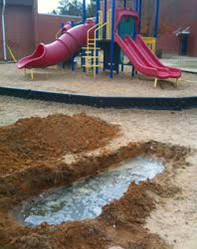
Remember the biofilm is aerobic on the outside, but below the surface it consists of mostly an anaerobic layer. These anaerobic bacteria use the sulfur from the waste as their source of energy. As we have seen, the byproducts of this bacteria include the form of sulfur called sulfides. Sulfides have a characteristic in which they react with metals, mostly iron in soil and water, to form a black, very insoluble, sticky material which is called iron sulfide.
With an oxygen rich environment, these sulfides slowly react with the oxygen to form the soluble sulfates which wash down into the soil. Demand for oxygen to turn sulfides into the soluble sulfates competes with the aerobic bacteria in the surrounding soil for available oxygen. If the system is in balance, there is oxygen for the aerobic bacteria in both the soil and the drainfield. This allows for the constant removal of the sulfides. This good balance helps determine the long term rate of absorption in the drainfield. Maintaining a oxygen balance in a septic system is crucial for overall function. Bacteria that serve to breakdown the waste depend on oxygen to survive. If the oxygen is depleted in a system, these bacteria will either die off or actually convert to anaerobic bacteria. In addition, the sulfide by-product of the anaerobic bacteria cannot be broken down without oxygen. Therefore, oxygen is required to deal with the anaerobic biofilm and control it’s buildup. It can cause the system to become unbalanced and start to drain slowly or stop working completely.
Again this moves the septic system into an unbalanced state and is almost entirely an anaerobic environment. As you can see, once this condition starts it multiplies upon itself. It can be corrected, but the best way to avoid it is to be aware of soil conditions and by spreading out your usage of water. How can this condition be fixed? One method is to stop adding water to the system. When a system rests (12 months or more) oxygen in the soil slowly oxidizes the sulfides and allows the clogging mat enough time to decompose. Another method is to reduce the amount of water and waste in the water going to the drainfield. Proper maintenance of the septic tank, a regular pumping schedule, and reducing the organic waste entering the system may help. This organic waste is not only food and human waste, but also soaps, detergents, and things such as shampoo and cream rinses. If the amount of water entering the system is consistently more and faster that can be absorbed into the soil in a period of time, the drainfield will become more anaerobic and develop problems.
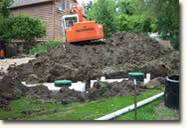
Another way of producing this situation is to hydraulically overload the system. Hydraulic overloading means adding water faster than the system can dispose of it into the ground. This results in standing water in the aggregate bed, surrounding soil, and eventually it can even come up to the surface above the drainfield. Overloading can be caused by not spacing out your water usage correctly, such as doing all your weekly washing of clothes in a one day period.
Leaky faucets or other plumbing can also cause an overloading of water into your system. Even conditions you have no control over can cause overloading of your absorption area, such as extended periods of rainy weather or local flooding. This overloading of water prevents oxygen from getting to the bio-mat and the ground below. As water stands in the drainfield for a long period of time, anaerobic conditions become predominate. This condition increases the production of sulfides, resulting in thickening of the bio-mat and the buildup of insoluble sticky black sulfides in the aggregate bed and surrounding soil.
In addition, Lenzyme Septic Kit can be used in working systems to help prevent the system from building up sulfides to the point that the water absorption is severely slowed. To help maintain this vital balance a system can benefit and should be treated monthly with pre-measured Lenzyme treatments and a bi-annual treatment of the Lenzyme Septic Kit.
What can be done to maintain or improve the water absorption in a drainfield? There are several techniques which can be used. These may be regulated in some states. If the drainfield is flooded, that is standing water above the laterals, soil fracturing may be used in some areas. This technique blasts compressed air into the drainfield to open paths through the clogging mat for the water to flow through. This may help the long term situation because more oxygen may be available and help reduce the sulfide build-up. The system may be rested for a period of time which may be as long as twelve months. This is probably not possible unless the system was installed with alternating drainfields connected by a valve to divert water from one to the other. Some people have enough room in the yard to add another drainfield along with the water diverting plumbing. This would allow them to use the new drainfield right away, but keep the old drainfield as a backup. Another way is to replace the old soil absorption area with a new modern design of drainage piping and new aggregate bed.
There are companies offering kits to convert the septic system from the traditional anaerobic system to an aerobic system. These kits use some type of air pumping unit to add oxygen to your septic system. This would over time have the effect of changing the chemistry and biology of the drainfield and eliminating the sulfides from the soil absorption area. Unfortunately, each of these methods can be very expensive and can also damage your landscaping. A failed system and the replacement of it will be a high stress situation for you. Cost, headaches, stress, mess, smell, and choosing a method of replacement are difficult. A simpler and less costly alternative is our Lenzyme Septic Kit restorer. It is an environmentally friendly chemical treatment used to oxidize the sulfides and release oxygen into the drainfield. This is essentially the same as letting the system rest for a year or more, except this works much faster. It is not uncommon to see results in the first 2-weeks.
The product is added between the septic tank and the drainfield. With Lenzyme Septic Kit restorer the use of your septic system does not need to be restricted during the treatment. However, the best results are obtained when the drainfield is dewatered down to the soil interface either by resting or by pumping the drainfield. The great thing with Lenzyme Septic Kit is no digging, no expensive equipment is needed, and treatment is usually substantially less than replacement. Lenzyme Septic Kit can be used for seepage pits, cesspools, and traditional drainfields. Lenzyme Septic Kit restorer is excellent for restoring flow to a slowed system or a failed system. In fact it has over an 80% success ratio in restoring fields to their normal capacity.
